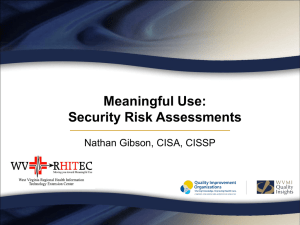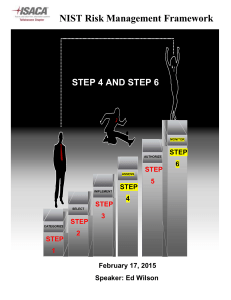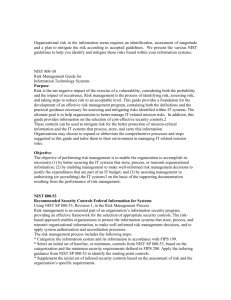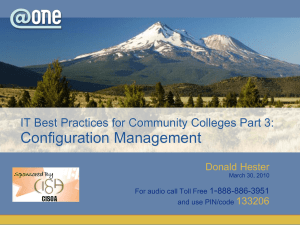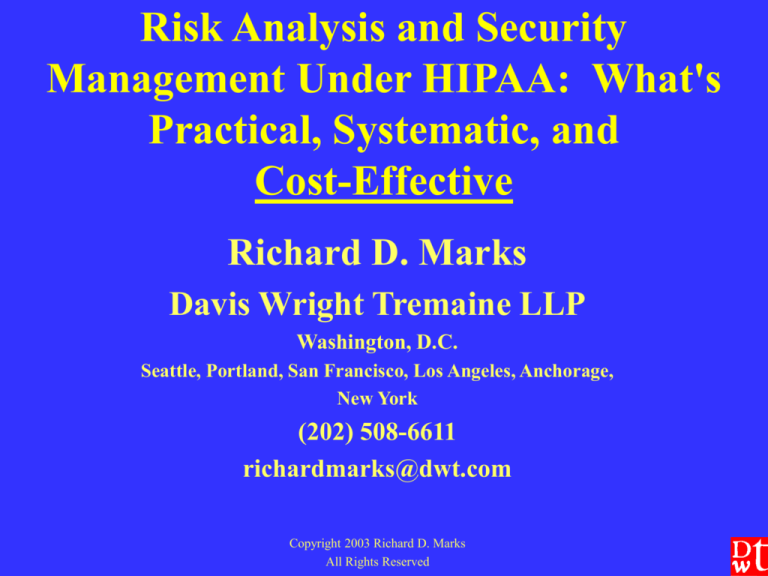
Risk Analysis and Security
Management Under HIPAA: What's
Practical, Systematic, and
Cost-Effective
Richard D. Marks
Davis Wright Tremaine LLP
Washington, D.C.
Seattle, Portland, San Francisco, Los Angeles, Anchorage,
New York
(202) 508-6611
richardmarks@dwt.com
Copyright 2003 Richard D. Marks
All Rights Reserved
Hypothetical for Analysis
University of Washington facts
4,000 complete records hacked
Hacker: I did it just to show you how bad
your security is - a warning
Suppose a hacker attacks your facility
and posts 4,000 records to the Internet
What’s the liability?
How could you have limited exposure?
How do you defend?
How do you mitigate?
What Will Plaintiffs Argue?
Virus ex machina = res ipsa loquitur
(2003 Stan Tech. L. Rev. 1, 2003)
Strict liability
“Ensure”
“Protect against any” threat, hazard, unauthorized use or
disclosure
“Exceptionally high goal” for security
“Best of its ability”
“ Must adjust its information security program in light of
changes in technology, the sensitivity of customer
information, the licensee’s own changing business
arrangements, outsourcing arrangements, and external
threats.”
Sarbanes-Oxley (or common-law equivalent): they
didn’t disclose their vulnerabilities!
What Does the Lawyer
Want to Tell Judge and Jury?
The hospital had a comprehensive, coherent security
plan
Plan complies with federal and state law
We were serious about it – we really followed it
What we planned, and what we did, created a feasible level of
security considering
The threats we face
The services we furnish
Our financial and budgetary situation
The technology available in the real world
Our plan, and how we carried it out, meets the standard
required by federal and state law
What Are the Keys in Court?
There is documentation of board participation
This is not a resolution saying, “we will comply with the
law.”
It is a record of board involvement in oversight of
Creating the “effective program”
Monitoring the “effective program” through its iterations
NIST 800 Series as the model for, or a major input to,
design of the effective program
Integration of risk analysis and effective risk
management in the System Development Life Cycle
(SDLC) of all systems that incorporate technology (not
just computer systems – business processes too)
Incident response – and all that it implicates (acid test)
“Effective program to prevent and
detect violations of law”
Establish compliance standards
High-level personnel must have been assigned overall
responsibility
Due care not to delegate substantial discretionary authority to
those with propensity for illegal activity
Effective communication of standards
Reasonable steps to achieve compliance with standards
Standards consistently enforced through appropriate
disciplinary mechanisms
All reasonable steps to respond once an offense is detected
(including preventing further similar offenses)
Same principles as Business Judgment Rule (insulating
corporate officers and directors from personal liability)
“Effective program to prevent and
detect violations of law”
The “applicable industry practice or the
standards called for by any applicable
government regulation” guide an organization
in implementing an effective compliance
program.
Question: What are the industry’s statutory or
regulatory mandates?
HIPAA - Statutory Standard
“Each [covered entity] … who maintains or transmits health
information shall maintain reasonable and appropriate
administrative, technical, and physical safeguards -(A) to ensure the integrity and confidentiality of the
information; and
(B) to protect against any reasonably anticipated
(i) threats or hazards to the security or integrity of the
information; and
(ii) unauthorized uses or disclosures of the information;
and
(C) otherwise to ensure compliance with this part by the
officers and employees of such person.”
(42 USC §1320d-2(d)(2); in effect now - does not require final
security or privacy rules to become effective)
HIPAA Security Standards
“Ensure” – Congress’ intent “was to set an
exceptionally high goal for the security of
electronic health information.”
“No such thing as a totally secure system that
carries no risks to security.”
Some trade-offs necessary – “ensuring” does not
mean providing protection, no matter how
expensive.
CE takes steps “to the best of its ability”
Balance: “identifiable risks and vulnerabilities”
versus cost of various protective measures (also
depends on CE’s size, complexity, & capabilities)
A Litigator’s View of “Best” Practices
In security field, “best practices” are at
NSA, CIA, etc.
In commercial security field, “best”
practices are at banks and other financial
institutions, or in defense industry
Health care prevailing industry practices
Not “best”
Superseded by HIPAA statute and regs
Consider “appropriate” or
“recommended” practices
Don’t make your expert vulnerable
Corporate Compliance Plan for
Information Security
Information security works best when procedures
are incorporated into a system.
Technology of these systems is rapidly evolving:
**Access controls
** Encryption
** Firewalls
** Intrusion/ anomalous event
detection and alerting
**Immediate incident response
Technology is 10% of security at most.
Security Management Process
More than technology; integrated with technology
Initial and on-going risk analysis – threat
assessment (outside experts?)
Enterprise security management process
Computer security (includes monitoring)
Communications security (includes monitoring)
Physical security: access to premises, equipment, people,
data
Personnel security
Procedural (business process) security
A pervasive security culture – awareness & surveillance
There Are Threats
Hackers
& Crackers
Hacktavists
Industrial/Corporate
Spies
Trusted Insiders
Employees
Consultants
Organized Crime
Terrorists
Aim: Corporate Compliance
Plan for Information Security
Risk
Analysis >
Threat Model
Response Model
Aligned with
Business
Goals &
Obligations
NIST 800 Series - The Reference of Choice
Security Standards, 68 Federal Register p. 8334 (Feb. 20, 2003)
Security Management Process (p. 8346):
SP 800-30, Risk Management Guide for Information
Technology Systems (2002)
Security Awareness and Training (p. 8350)
SP 800-16, Information Technology Security Training
Requirements (1998)
Audit Controls (p. 8335)
SP 800-14, Generally Accepted Principles and Practices for
Securing Information Technology Systems (1996)
SP 800-33, Underlying Technical Models for Information
Technology Security (2001)
NIST 800 Series Publications – A Sample
SP 800-30 Risk Management Guide for Information
Technology Systems, January 2002
SP 800-26 Security Self-Assessment Guide for Information
Technology Systems, November 2001
SP 800-31 Intrusion Detection Systems (IDS), November 2001
SP 800-33 Underlying Technical Models for Information
Technology Security, December 2001
SP 800-41 Guidelines on Firewalls and Firewall Policy,
January 2002
SP 800-45 Guidelines on Electronic Mail Security, September
2002
SP 800-14 Generally Accepted Principles and Practices for
Securing Information Technology Systems,
September 1996
SP 800-16 Information Technology Security Training
Requirements: A Role- and Performance-Based
Model, April 1998
http://csrc.nist.gov/publications/nistpubs/
NIST 800 Series
Risk Assessment Methodology
Step 1.
Step 2.
Step 3.
Step 4.
Step 5.
Step 6.
Step 7.
Step 8.
Step 9
System Characterization
Threat Identification
Vulnerability Identification
Control Analysis
Likelihood Determination
Impact Analysis
Risk Determination
Control Recommendations
Results Documentation
NIST 800 Series
Risk Assessment Methodology
http://www.csrc.nist.gov/asset/
The purpose of ASSET is to automate the completion of the
questionnaire contained in NIST Special Publication 800-26,
"Security Self-Assessment Guide for Information Technology
Systems.“
As described in NIST Special Publication 800-26, the results of the
questionnaire provide a "method of evaluating the security of a
particular system or group of systems." Through interpretation of
the questionnaire results, users are able to assess the information
technology (IT) security posture for any number of systems within
their organization and, in particular, assess the status of the
organization's security program plan.
Security Breaches
Wireless Devices
Extremely useful for
Patient care
Transcription
Order entry
Remote consults
HIPAA administrative issues
Security issues
Intercepts - encryption helps a great deal
Lost (or stolen) on the [subway] - physical access
Authenticating access
DOD/ NIST: Restrictions on wireless LANS
Intercepts (1,000 feet minimum)
No true access port authentication (IEEE 802.11/802.11b)
Inherent Tensions in the Security Rule
Covered entities need enforce BAC only if:
CE knows of
BA’s pattern or practice = material violation
CE unsuccessful at getting BA to cure breach or end
violation
Security Management
Ps&Ps “to prevent, detect, contain, and correct security
violations”
Incident response, access controls, integrity controls
Reference: NIST 800 series
Requires constant monitoring & coordination
BA must report all security incidents (attempted or
successful unauthorized attacks)
OHCA Security Issues
Provider OHCAs – implicit or explicit “holding
out” to the public
Security Responsibilities
Comprehensive and coherent security
Shared/ interfaced systems
SDLC both real & documented?
Security controls?
Where are the vulnerabilities? Backdoors?
Where are the responsibilities/ liabilities?
Allocation under a HIPAA compliance agreement?
Treatment in vendor contracts?
Real World of the Hospital/OHCA
Verisign
issuance of 3 spoofed certificates for
use on MSN. Question: how many others?
Same facts at a hospital/OHCA:
Could
not trust anything on the system.
Safety/ malpractice concern (remember systems
integration issue?)
Must you take the whole system down?
If so, how do you function? Dangers?
What’s
the systems answer in managing risk?
Constant
hot backups?
With ongoing integrity checking and encrypted
storage?
Can you document precautions in SDLC?
Intrusion/Anomalous Event Detection:
Incident Response – the Acid Test
Internal Network (location of intrusion/ anomalous
event detection + logging)
Firewall
Proxy firewall
Virtual Machine
Outsourced monitoring service
Detection is useless without the ability to analyze
attack and respond very fast (“real time”) and
effectively
“Mitigate”
Preserve Evidence (clocks synchronized?)
Expense v. Security Achieved
100% Security
Dollars
Security Achieved
NIST 800 Risk Mitigation
When vulnerability (or flaw, weakness) exists - implement
assurance techniques to reduce the likelihood of a
vulnerability’s being exercised.
When a vulnerability can be exercised - apply layered
protections, architectural designs, and administrative controls
to minimize the risk of or prevent this occurrence.
When the attacker’s cost is less than the potential gain - apply
protections to decrease an attacker’s motivation by increasing
the attacker’s cost (e.g., use of system controls such as limiting
what a system user can access and do can significantly reduce
an attacker’s gain).
When loss is too great - apply design principles, architectural
designs, and technical and nontechnical protections to limit the
extent of the attack, thereby reducing the potential for loss.
NIST 8000 Risk Mitigation Activities
Step 1
Step 2
Step 3
Step 4
Step 5
Step 6
Step 7
Prioritize Actions
Evaluate Recommended Control
Options
Conduct Cost-Benefit Analysis
Select Controls
Assign Responsibility
Develop Safeguard Implementation
Plan
Implement Selected Controls
Contracting For Security
General HIPAA Rule 1: When creating,
moving, or storing PHI with a counterparty,
the standard of care requires using a contract.
(Exception: provider-to-provider for treatment)
(Don’t forget verification!)
NOTE: People will object on grounds of
inconvenience, and expense (eg, we haven’t
used written trading partner agreements in
the past)
Response: Read the statute and the rules!
Contracting for Security
General HIPAA Rule 2: When drafting a contract
involving PHI, use a checklist.
Trading partner agreement – UCC Article 4A; Federal Reserve Reg. J
Consumer – EFTA and Regulation E (Federal Reserve)
ESign and UETA
Disclaim application of UCITA (MD & VA)
Prudential considerations (e.g., state tort law + HIPAA statute; state
contract law; state and federal consumer protection laws; criminal
sentencing guidelines + business judgment rule)
ERISA (e.g., health plan sponsor’s monitoring duties)
Fast-pay laws and their fraud-and-abuse consequences
Security rules – specific requirements, prudential considerations
TCS rules – 45 CFR § 162.915
Security rule requirements (computer acquisitions – don’t forget SDLC!)
Privacy rule requirements
Security
When does it apply?
What’s its scope?
Wrong answer: 26 months after final security
rule appears in Federal Register
Immediate concern: 42 USC §1320d-2(d)(2)
applies now to “health information”
45 CFR §164.530(c) requires appropriate
security measures when the privacy rules are
implemented on April 14, 2003 (brings
application of the final security rules forward)
What’s Different After Enron?
The Sarbanes-Oxley Act of 2002, Pub. L. 107-204,
116 Stat. 745 (2002)
Emphasis on management’s responsibility “for
establishing and maintaining an adequate internal
control structure and procedures for financial
reporting”
Reporting obligations cover more than GAAP
matters, extending to material operational issues.
A secure information infrastructure is central to
many companies’ operational capabilities. Hence,
the material condition of the business will be
assessed, and certified by officers, in that light.
What’s Different After Enron?
Result: a new standard of care for corporate
information security
Founded on GLB & HIPAA statutory
standards
Reinforced by state case law and regulatory
standards (GLB)
Formalized by Sarbanes-Oxley disclosure
requirements for publicly traded
companies
Prediction: this standard of care will transfer
to non-profits, then to enterprises generally
What’s Different After Enron?
5 recent (2002) Delaware Supreme Court
opinions siding with shareholders in claims
against directors.
Delaware Chief Justice Norman Veasey’s
comments at U. of Delaware’s forum on
corporate governance, Oct. 2002:
“Directors who are supposed to be
independent should have the guts to be a pain
in the neck and act independently.”
What’s Different After Enron?
NY Attorney General Eliot Spitzer (press release, Jan. 29,
2003), proposing to apply corporate reform provisions of
Sarbanes-Oxley to nonprofit organizations, to achieve
"accountability" for nonprofit entities in NY, because they
“have custody of billions of dollars in charitable funds.“
U.S. Sentencing Commission’s action (Jan. 10, 2003)
adopting an emergency plan for harsher sentences in
corporate crime cases.
New California law (SB 1386) requiring any online business
serving customers in California to notify customers of
computer security breaches that reveal customers’ names in
association with an identifying number (e.g., SSN, driver’s
license, credit card). (Will companies doing business in
California find it necessary to notify all customers, wherever
located? How does this change operations for banks and
financial companies, which often do not publicize hacks?)

